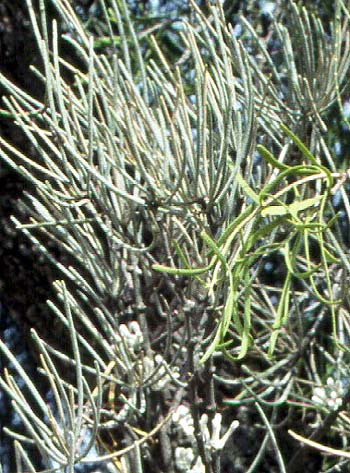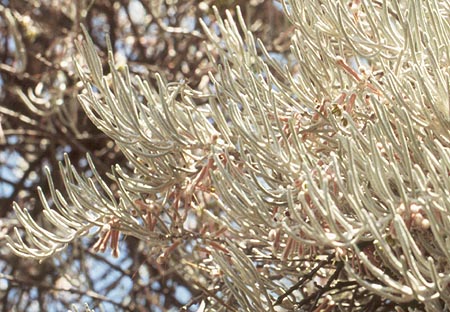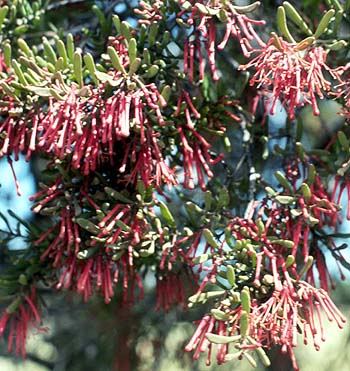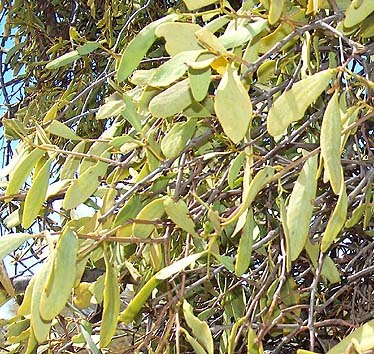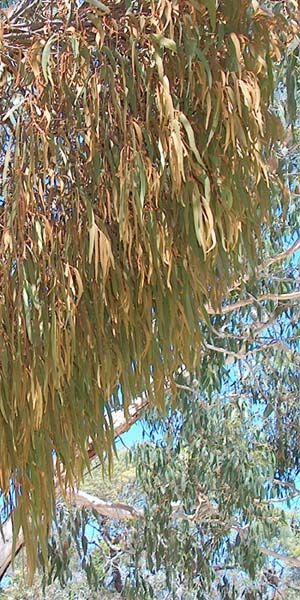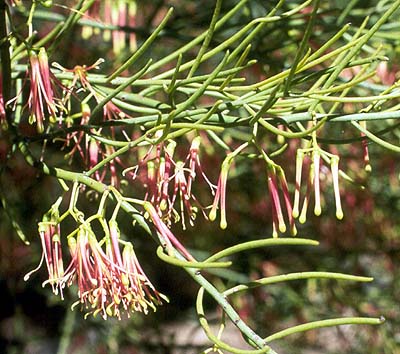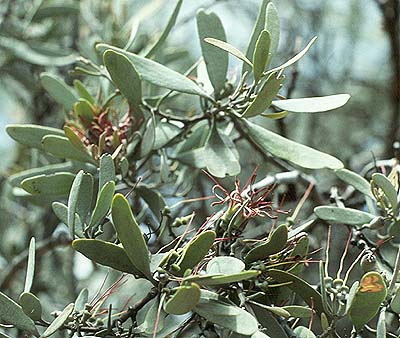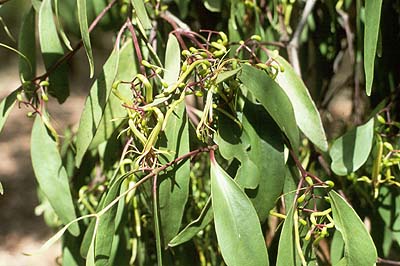The genus Amyema contains 12 species in South Australia, which are widespread throughout the state, and it is the only genus to extend beyond Australia. Its members parasitise (often very specifically) a wide range of native plants.
The genus Diplatia occurs as 1 species in South Australia, and it almost exclusively parasitises the Coolibah gum-tree that grows along the ephemeral rivers and creeks in the Far North Region of the state. It is not utilised by butterfly larvae.
The genus Muellerina also occurs as 1 species in South Australia, where it is restricted to the cool, high rainfall areas of the Lower Southeast Region. It parasitises mainly Eucalyptus and Acacia, but is also known to occur on ornamental trees.
The genus Lysiana contains 3 species in South Australia, and they occur throughout the state. They parasitise a wide range of hosts, and the most common species, which occurs in southern urban areas, is particularly fond of introduced trees. This genus is also not utilised by butterfly larvae in South Australia.
Mistletoes are aerial parasitic plants that use other plants to obtain their water and mineral nutrients. However, they usually undertake their own photosynthesis through their leaves. They are not known to be parasitoid, such that they willingly kill their hosts, as this would lead to their own demise. Mistletoes are used as larva foodplants by butterflies, particularly by the family groups Pieridae and Lycaenidae. In particular the generic groups of Delias (Pieridae) and Ogyris (Lycaenidae), both of which contain very colourful, and often rare butterflies.
The mistletoes in Australia belong in two family groups, Loranthaceae and Viscaceae. Only members (genera) of the Loranthaceae are used as larva foodplants in South Australia. There are four genera in Loranthaceae that occur in South Australia, being Amyema, Diplatia, Muellerina and Lysiana.
Many of the mistletoes are very host specific, and as such have often developed leaf foliage that mimics the foliage of the host plant. They reproduce from single seeds contained within small, sweet, sticky fruits, which when attached to the branches of the host plant develop into new mistletoe plants. When the seeds germinate, a modified root penetrates the bark of the host's stem and forms a connection through which water and nutrients pass from the host to the mistletoe. They do this by melding their root structure into the woody structure of the host's stem, and thereafter it becomes a living part of the stem receiving all the nutrients that the foliage of the host plant receives. The mistletoe attachment is called a haustorium, which is usually more enlarged than the rest of the mistletoe stem, and in nearly all species occurring in South Australia, is a single attachment. Only Muellerina has multiple haustorial attachments, produced from epicortical runners that look like roots along the host's branch. The mistletoe fruits are usually spread by birds, and most particularly by the small Mistletoe Bird (the male is spectacularly red breasted like a robin), which almost exclusively feeds on the mistletoe fruits.
The mistletoes likely to be encountered in the populated southern agricultural and urban belt of South Australia are Amyema linophylla, A. melaleucae, A. miquelii, A. miraculosa, A. pendula, A. preissii, A. quandang, Lysiana exocarpi and Muellerina eucalyptoides. All except Lysiana exocarpi are used as larva foodplants by butterflies. The butterflies that utilise mistletoes in South Australia are Ogyris abrota, O. amaryllis, O. barnardi, O. olane, O. oroetes, O. genoveva, and Delias aganippe. In the case of Ogyris, the mistletoe is an obligatory foodplant, and its demise will also destroy the butterfly.
Mistletoes are used by many animals, birds and insects as food sources, either by directly eating the plants and their fruits, or by using the nectar from the flowers. For example, the brushtail possum will eat both leaves and fruits, birds eat the fruits, birds and small possums and insects (particularly butterflies and moths) use the flowers for pollen and nectar, and the larvae of a very large number of both butterflies and moths will eat the leaves and flowers.
In recent years it has been noticed that the densities of some mistletoes have increased, particularly on Eucalyptus (Amyema miquelii) and Acacia (Amyema preissii). This has caused some people to advocate the destruction of all mistletoes in the belief that the mistletoes are killing the host. In fact, mistletoes are not parasitoid, and as such they do not willingly kill their hosts, as this would lead to their own demise. In most cases, both mistletoe and host seem to be able to live together without undue effect on each other. For example, the bonding of Amyema quandang and Acacia papyrocarpa can be for a 100 years or more (and there are some recent estimates of more than 500 years), and a similar relationship can occur for Amyema melaleucae and Melaleuca lanceolata, and also for Amyema linophylla and Bull Oak (Allocasuarina luehmannii).
There are some cases of Amyema preissii being seen to occur on dying Acacia, but in most of these instances the Acacia is either a short lived variety, or the mistletoe is parasitising a non-indigenous Acacia that is under stress.
However, there are now many instances of Amyema miquelii occurring in high densities on certain, dying Eucalyptus, particularly E. fasciculosa (Pink Gum), and sometimes over large areas. Unfortunately, there has been no scientific study to determine the reasons for this, and it is not known whether such a coincidence ever occurred historically before widespread vegetation clearance occurred. It is now believed the most likely reasons for this mistletoe becoming a threat to Eucalyptus is human mismanagement of the environment, such as activities which have interfered with the natural ecological balance that places an unnatural stress on the Eucalyptus. Such causes include massive vegetation clearance leading to a leaching of soil and farming chemicals from the cleared areas into the uncleared areas causing an imbalance in the soil chemicals, the clearance of understorey shrubbery from around large trees, changes in the local microclimate leading to acid rain among other phenomena, lowering of the water table by the excessive use of subterranean water and the instillation of artificial drainage, incursion of soil salinity due to over irrigation or loss of vegetation, the introduction of phytophora or 'mundulla yellow' diseases, overuse of chemicals both to the soil and to the atmosphere, loss of the natural mistletoe herbivores, etc. Even koalas may have a local effect by overgrazing the Eucalyptus foliage, and leaving the mistletoe untouched. In most cases where there is an imbalance between the A. miquelii and its Eucalyptus host, it occurs in either urban areas or in intensive-use agricultural areas that have been subjected to massive clearance and degradation.
In such cases it is unlikely that the removal of the A. miquelii mistletoe will have a lasting effect, and that the Eucalyptus will ultimately die anyway, unless the underlying cause of the stress can be remedied. Stressed Eucalyptus can also be targeted by lerp (Psyllidae) which can cause a complete defoliation (leaf browning), and quite often the Eucalyptus is unable to recover from such an attack and both it and the mistletoe will die. Once critically stressed, the Eucalyptus are attacked by the larvae of borer beetles and at that stage the death of the Eucalyptus is inevitable.
Ad hoc removal of Amyema and Muellerina mistletoe is not recommended for beautification purposes as there is normally a self induced balance between the mistletoe and host. The removal of Lysiana exocarpi from a favourite fruit or ornamental tree would be no great loss to the butterfly community since it is not used by butterflies, and the mistletoe is very common anyway. The removal of any Amyema miquelii is fraught with danger to populations of the rare Ogyris genoveva butterfly. If it is deemed that thinning of this mistletoe is required, then the host tree needs to be first checked for the presence of this butterfly. This can be done in the first instance by very carefully checking around the base of the host tree for the presence of the large (harmless) Camponotus sugar ants. If they are present then there is a good chance that a larva colony of the butterfly exists at the base of the tree, and therefore thinning should either not occur or be very judicial. If the butterfly colony is strong, then it will keep the mistletoe pruned anyway.
- Buloke Mistletoe
-
Amyema linophylla has grey-white, erect flowers (pointing upwards), and long (60-120 mm), tomentose wiry, erect, grey-white coloured leaves. It exclusively parasitises Bull Oaks and She Oaks (Allocasuarina), and occurs in the southeast portion of the state and interestingly also on Kangaroo Island (but not along the Mt Lofty Ranges). It is itself often parasitised by Lysiana exocarpi (the pale-green leaved mistletoe in photo below).
- Hakea Mistletoe
-
Amyema gibberulum has pink flowers and long (50-100 mm), tomentose wiry, erect, white coloured leaves. It exclusively parasitises Hakea and Grevillea in northern pastoral areas.
- Melaleuca Mistletoe
-
Amyema melaleucae has red, drooping flowers, and short (20-45 mm), narrow (2-4 mm), slightly thickened, smooth, yellowish green leaves. It exclusively parasitises Melaleuca trees, particularly M. lanceolata and less often M. halmatuorum, and occurs mostly in near-coastal situations.
- Fleshy Mistletoe
-
Amyema miraculosa has red, drooping flowers, and has small leaved (40-100 mm long, by 5-25 mm wide), slightly thickened, smooth, green coloured leaves. It parasitises many types of trees and bushes, but especially Santalum (quandongs and sandalwoods), Myporum, casuarinas and other mistletoes. It occurs in the drier areas of the agricultural belt and in southern pastoral areas.
- Box or Smooth Drooping Mistletoe
-
Amyema miquelii has red, drooping flowers that occur in triads with the central flower of the triad having a stalk, and long (30-250 mm), smooth, Eucalyptus shaped, yellowish coloured leaves, which are usually drooping (from where one of the common names of this mistletoe derives). It occurs throughout the state (in variable densities), and almost exclusively parasitises Eucalyptus trees.
- Furry Drooping Mistletoe
-
Amyema pendula is similar to Amyema miquelii, but the young leaves are rusty-brown tomentose and the central flower of the triad is not stalked. It parasitises Eucalyptus (particularly stringy-bark types) and certain Acacia trees like Amyema melanoxylon (Blackwood), and occurs in the cool, wetter areas of the South Mt Lofty Ranges and the Southeast Region.
- Wire-leaf Mistletoe
-
Amyema preissii has red, drooping flowers, and short (20-80 mm), wiry, smooth, green coloured leaves. It almost exclusively parasitises Acacia trees, but sometimes occurs on Senna bushes, and occurs throughout the state.
- Grey Mistletoe
-
Amyema quandang has grey-red, erect flowers, and has small (40-100 mm long, by 8-40 mm wide), slightly tomentose, grey coloured leaves. It almost exclusively parasitises Acacia papyrocarpa (Western Myall) trees, but sometimes parasitises other Acacia trees, and occurs mainly in southwest pastoral areas of the state (northern Eyre Peninsula).
- Harlequin Mistletoe
-
Lysiana exocarpi has green and red (or yellow), long erect flowers, and narrow, falcate (30-150 mm long by 1-10 mm wide), smooth, green coloured leaves. It parasitises many types of trees, bushes and other mistletoes, but in southern areas it is particularly fond of introduced trees. It occurs throughout the state. It is only likely to be confused with Amyema miraculosa, from which it differs in usually having longer and narrower leaves that do not have a distinct stalk, and the flowers occur as a single pair from the leaf axils (whereas the flowers occur as two groups of three on a single stalk in Amyema miraculosa).
- Creeping Mistletoe
-
Muellerina eucalyptoides has green and red, drooping flowers, and long (80-200 mm), smooth, Eucalyptus shaped, drooping, green coloured leaves. It parasitises mainly Eucalyptus and Acacia, but is also known to occur on ornamental trees, and is restricted to the cool, high rainfall areas of the Lower Southeast Region. It can be confused with Amyema miquelii and Amyema pendula, from which it differs in having green leaves that are often more bunched (less droopy), the flowers are yellow-green coloured, and it has multiple haustorial attachments, produced from epicortical runners that look like roots along the host's branch (from where the common name derives).
